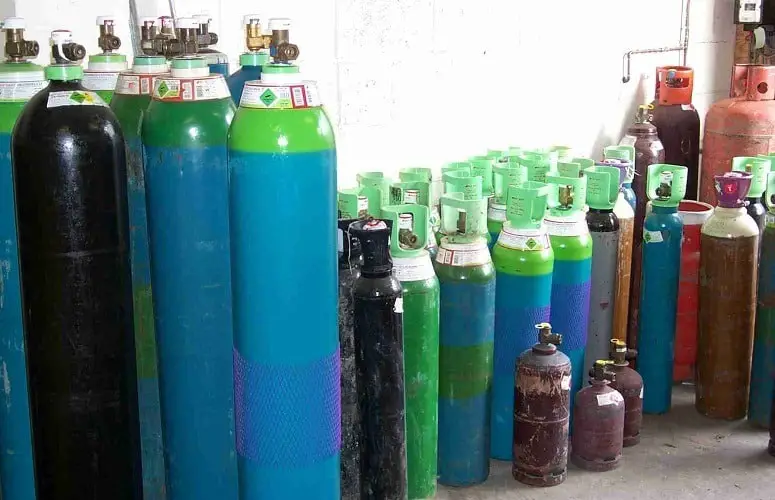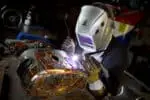 Welding is a process that needs to be done only after the whole technique is decided. The two major techniques as you know are MIG and TIG. Often there rises a question about how interchangeable these two techniques are. But, digging deeper you may ask whether the gas used for MIG be used for TIG?
Welding is a process that needs to be done only after the whole technique is decided. The two major techniques as you know are MIG and TIG. Often there rises a question about how interchangeable these two techniques are. But, digging deeper you may ask whether the gas used for MIG be used for TIG?
This blog will tell you more about this.
MIG gas cannot be used for TIG welding. This is because of the properties of the gases used in the two methods. Yet there are times where certain gases are mixed to give the desired effect in TIG welding.
What are the types of gases used in MIG welding?
MIG the name itself says Metal Inert Gas. In this mode of welding gases used tend to be reactive. They easily cause changes in metals when they get in touch with other elements.
The most commonly used gases in MIG include the following:
Argon
This gas is used for narrower penetration. There are a few benefits of using Argon as shielding gas such as reduced post welding clean up, and gives a smooth weld quality. Moreover, this gas gives much more control of weld puddles than other gases.
However, for MIG, Argon is rarely used in its pure form. It is preferred to be mixed with other gases like oxygen, helium, and hydrogen. It enhances the characteristics of the arc. This mixing is done for the weld to be done with minimum disruptions and thereby resulting in a weld with a finished look.
Argon when mixed with carbon dioxide is the best combination for stainless steel and carbon metals. The carbon dioxide level should not go beyond a limit or else the spatter nuisance will be high. Often the percentage ranges from 75 to 95% argon to 5-25% CO2.
Oxygen
Like other MIG gases, Oxygen is also reactive. Usually, it is mixed in a limit of 9% or less. It is recommended not to mix oxygen with magnesium, copper, aluminum, or other exotic metals as it results in oxidation.
Mixing oxygen helps to improve weld pool quality, arc stability, and penetration in low alloy, mild carbon, and stainless steel.
Too much oxygen can affect the welding affecting the fluidity of the welding puddle making out of position welding difficult.
Helium
Helium is used in the mix along with Argon and CO2 for stainless steel. It is generally used for thicker metals and a ratio range between 25 to 75% with 75 to 25% Argon. By adjusting the percentages of the mix, the speed, penetration, and quality of weld can be decided.
One significant quality of Helium is the ability to create a hotter arc that results in much higher productivity than other gases due to the increase in speed of the arc.
But, unlike Argon, helium requires a higher flow rate and is expensive as well. You need to give thorough research before deciding to use helium as flow is high you might end up using a lot.
Carbon Dioxide
Of course, you would know it by now. Carbon Dioxide or CO2 is the most commonly used gas in MIG welding. In the case of CO2, you don’t have to mix it with any other gas. As you don’t have to mix it with any other gas, you can reduce the cost that much.
But, the downside of using pure CO2 is that it can result in a lot of spatter and a less stable arc. It is also applicable only for short circuit processes of welding.
If you are going for works where the weld would not be seen or need to be of a smooth look then CO2 is apt for that work. Often the less stable arc and spatter resulting from pure CO2 result in craters in the weld that creates the unaesthetic weld.
What type of gas is used in TIG welding?
There is only one answer to this question. And that is Argon. Argon is the gas used in TIG welding due to the fact that it is an inert gas that never reacts with other elements.
As TIG uses tungsten rod, the gas used for shielding shall not react with it and this is possible only with Argon. As a result, when Argon is used, it creates an inert atmosphere and thus helps in creating a stable arc.
Apart from these, there are a few other reasons why Argon is preferred for TIG weld. It is very efficient in creating a protective shield around the focus area and in the prevention of the formation of oxides. If needed as mentioned in the case of MIG, Argon can be blended with other gases to improve the welding process.
Argon is also preferred for TIG for the fact that it limits the discoloration that happens as a result of welding. This happens due to the diffusion or evaporation of important elements making way for rust.
With Argon, this can be highly mitigated. It also means post-cleanup is also very fast when it comes to TIG welding using pure Argon. The weld need not be cleaned afterward unlike MIG and this is a huge advantage.
It is a very versatile gas that can be used on a variety of metals such as aluminum, stainless steel, and mild steel. Non-ferrous metals like magnesium, titanium, and aluminium exclusively require Argon for welding.
What will be the result if the MIG mix is used in TIG welding?
If MIG mix is used for TIG gas the result will never be satisfactory. Numerous tests have been done and you can see them on the internet. So what exactly happens there?
With pure TIG welding (100% Argon) what you get is a smooth almost spatter-free weld. It will never be a troublesome process and the weld will also be with less disfiguration.
For the same surface, if you use MIG mix, let’s say Argon+CO2, the result will be disappointing. The change in the atmosphere can be easily noticed.
You can easily observe how erratic it is when the arc touched the surface of the weld. Smoke and spatter will be high. If you observe the welded surface you will be able to see the craters and how discolored the area is.
So why the MIG mix is not working for TIG?
The whole answer comes to the properties of the Gas used. By now you are aware of how each gas works and what its characteristics are.
As mentioned earlier, Argon is the only choice for TIG, due to the presence of Tungsten rod and it keeps the environment clean and inert. Any sort of disruption to this may result in a weld that is not desirable.
So why in certain rare cases other gases are mixed with Argon for TIG welding?
Yes, you heard that right. There are instances when gases are indeed mixed with Argon to give the desired result in TIG welding. This is done only when the work is demanding it as there is no other choice.
For instance, helium is added with Argon in rare cases for welding in stainless steel and aluminum. In the case of aluminum, this mix is needed for the purpose of wetting out the weld and in smoother penetration.
In certain other cases, helium or hydrogen are added in 1 to 2% to raise the arc stability and voltage. This in turn would help in increasing the heat of the arc thereby resulting in a smoother weld. Nitrogen is also added with Argon in rare cases for duplex stainless steel.
Hope this article gave the answer to your doubts about using MIG mix for TIG welding.
Do visit other writings on our site to see more such informative blogs!






